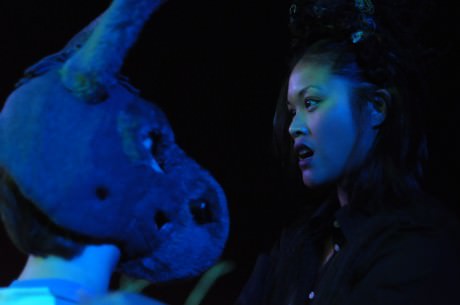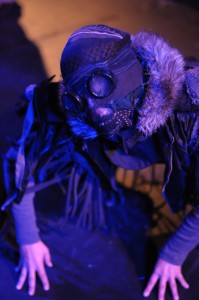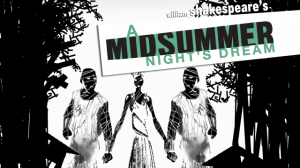Perchance you dream some feverish faerie nightmare but why dream it when you can see it played out in vibrant color as Glass Mind Theatre presents Shakespeare’s A Midsummer Night’s Dream as the opening show of their third season. Directed by Elissa Goetschius, this production wafts like a cloud as a dream through your mind bringing a darker edge and more macabre feeling to the faeries of the night. William Shakespeare’s classic comedy is newly revived with interpretive dance sequences to spice up the show and a unique twist on double casting characters, playing up and downplaying different roles, and two Pucks.

Scenic Designers Ryan Haase and Jessica Ruth Baker incorporate a whimsical feel to the production with their intimate fantasy forest setting. Placing the audience on stage in a tennis court fashion it brings a deep level of intimacy to the performance that would not be afforded if the full house of the autograph playhouse were to be used instead. Haase and Baker explore the darker side of this fairy tale in a subtle homage to styles similar to Tim Burton with spindly dead trees in shades of snow white and flesh pink poking upward at various angles, topped with spirals of white thorns. Having the audience so close also allows for onlookers to feel as if they are part of this wild nightmarish dream rather than just observing it.
Choreographer Sandra Atkinson works to incorporate bizarre yet meaningful dance routines into the comedy. Atkinson shows a range of odd full-body movement pieces that incorporate accents of ballet, line dancing, disco dancing, and many other genres to enhance the nonsensical whimsy of this show. The opening dance routine is filled with jovial spirit, playing out as an invitation between the four Athenians welcoming the audience to their folly. Atkinson uses dance for character introductions, particularly with the troupe of pathetic performers, and utilizes these unique choreographed moments to heighten critical moments of the show,like the triple wedding.
Director Elissa Goetschius makes unique choices in her double billing, cleverly casting most of the players from the performing troupe as the faeries at attend the faerie queen. While doing so she cuts back nearly all of said faerie dialogue, making them but mere dark shadows that linger ever-present at Titania’s side. Goetschius also creates a spot of intrigue by casting not one actor as the miscreant Puck, but two. The second actor serves as ‘Shadow Puck’ never speaking but snarling and skirmishing along the ground beside actual Puck, giving the real character something to physically play against and appear with. This bold choice makes for a dark and entertaining series of moments when Puck appears throughout the play.
Puck (Elizabeth Galuardi) dressed as a creeping black gremlin in a Steampunk facemask is a dark incarnation of this sprightly faerie. Galuardi spends her time embodying a grotesque sort of creature that grovels and scrapes about the stage, speaking in harsh tones that show the characters malicious and mean-spirited side rather than the more fun-natured mischief that is so often associated with the character. Her shadow double, Justin Johnson creates a sharp contrast, literally moving about like her shadow in darkness, making it doubly dangerous to cross paths with the imp.
The nonsense and shenanigans of the performance troupe is wildly entertaining as they rely mainly on their bodies physical and nonsensical expressions to derive humor from their brief scenes. Snug (Justin Lawson Isett) in particular gives us a great deal of laugh-out-loud moments as he tries and fails to produce his lines, gesturing with epic intent that leaves you hanging while he fumbles for words. But the leader of this band of hooligans is seen not in Peter Quince (Kevin Griffin Moreno – who gives a sporting good shot at deadpan humor) but in Bottom (Maxwell R. Heaton).

Heaton’s approach to the character is an over the top dramatic caricature of the mindless self-obsessed actor. He’s clearly enjoying what he’s presenting to the audience, making us all the more able to enjoy it. He plays up his role with the bright shiny glaze of a Christmas ham and is not to be outdone even when befitted with the furry donkey head. Heaton has engaging eyes and is hysterical as he tries to recall his dream to the audience; a performance well baked if ever there was one.
Ring leaders of the faeries come in male and female. Cori Dioquino gives a frosty approach to the Faerie Queen Titania, making her scornful and bitter. Dressed like a widow in mourning, Dioquino doesn’t so much move across the stage as she does float with a supernatural grace, her words gliding along the same ice as she wings verbal daggers at Oberon’s heart. Oberon (C-Mo Molloy) is equally macabre in his appearance and twice as frightening as any other instance of the Faerie King I’ve yet to see. Molloy blends into the shadows of the stage and literally appears from nowhere at times, his striking presence quite frightening as he hisses his monologues. Together Dioquino and Molloy – also doubling up as the Duke Theseus and fair Hippolyta – create intricate relationships of love and loathing, a challenge well received and well played by these two seasoned performers.
And the crux of our story comes down to the lovers quadrangle. Hermia (Amy Parochetti) loves Lysander (Alexander Scally) but is supposed to marry Demetrius (Lance Bankerd) but Helena (Sarah Ford Gorman) is in love with the one her best friend is supposed to marry. Confusing? These four performers do an immaculate job of keeping that storyline straight. All four of them craft ingenious versions of these characters bringing them to vibrant life in their arguments and spats.

The pivotal moment of this show comes when the faeries have played their pranks and the four Athenians are verbally abusing one another over who loves whom. Gorman as Helena creates a deeply dynamic dichotomy in her character’s love and affections. One moment she is truly lovesick and obsessive in a pathetic way, pining over Bankerd’s character, following him like a lost puppy. But then before her epic woe can consume her heart she flashes into a vicious scorned woman who refuses to be mocked, bellowing insults and upsets at the top of her emotion drenched lungs. Gorman steals everyone’s attention when they begin to toss her about like a ragdoll between Bankerd and Scally – who have fallen dumbstruck in love with her.
The physical brawl and scampering across the stage that occurs during the aforementioned scene is the most engaging and hilarious scene of the show. As Parochetti goes on the attack with Gorman defending in her wild and wily way the two females are at each other’s throats physically and literally with Scally and Bankerd becoming emotional and physical walls to prevent true harm and disaster. It’s an uproarious and compelling moment that will have you routing for love and hate all in one go.
If this review hath offended, think nothing more of it as it was likely only a dream, but if you were pleased by what you read my words can only do their shenanigans but so much justice, and a ticket is what you now seek to purchase.
Running Time: Two hours and 40 minutes with one intermission.
A Midsummer Night’s Dream plays through October 7, 2012 at Glass Mind Theatre at the Autograph Playhouse – 9 West 25th Street, in Baltimore, MD. Tickets may be purchased at the box office starting 45 minutes prior to show time and may also be purchased online.





